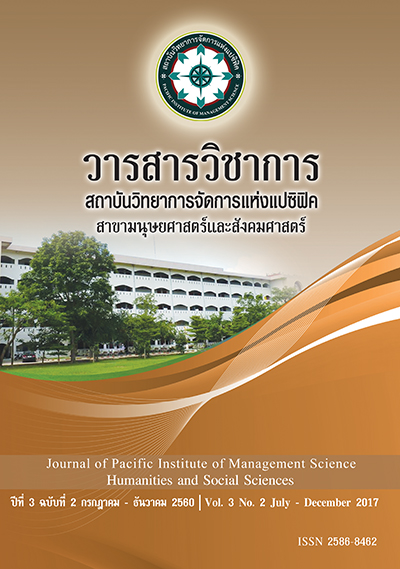THE DEVELOPMENT OF COMPUTER ASSISTED INSTRUCTION OF LEGITIMATE DRAMA MATHANABADHA FOR MATTHAYOMSUKSA 5 STUDENTS
Keywords:
Computer Assisted Instruction, Legitimate Drama MathanabadhaAbstract
The purposes of this research were 1) to develop of Computer Assisted Instruction (CAI) on Legitimate Drama Mathanabadha for students in Matthayomsuksa 5 students; 2) to compare the students’ learning achievement before and after using the CAI program; and 3) to investigate the student’s attitudes toward the CAI lesson. This research was an experimental research. One-Group Pretest-Posttest design was used. The sample of this study was thirty secondary students in Matthayom 5 who registered in the second year of the 2016 academic year at Princess Sirindhorn's College. The simple random sampling technique was used in this study. The duration of the experimental research covered 6 hours. The research instruments used in this study were consisted of: 1) the CAI program of Legitimate Drama Mathanabadha; 2) the lesson plans for Legitimate Drama Mathanabadha; 3) the achievement test using the pretest and posttest of CAI program which consists of thirty multiple-choice items with four options per item; and 4) five-point likert scale questionnaires containing 21 questions on the students’ attitudes toward the CAI. The data obtained was analyzed using means the standard deviation and t-test dependent.
The results were as follows:
- The efficiency score of the CAI program of Legitimate Drama Mathanabadha was 80.00/83.76;
- The students’ achievement after using the CAI lessons was significantly higher at the level of .01;
- The students’ attitudes toward CAI program were highly positive.
References
กิดานันท์ มลิทอง. (2543). เทคโนโลยีการศึกษาและนวัตกรรม. กรุงเทพฯ: คณะครุศาสตร์จุฬาลงกรณ์มหาวิทยาลัย
กุสุมา รักษมณี. (2547). วรรณสารวิจัย. กรุงเทพฯ: ภาพพิมพ์.
เกรียงศักด ิ์ รอดเล็ก. (2555). “การพัฒนาบทเรียนคอมพิวเตอร์ช่วยสอน สาระการเรียนรู้ภาษาไทยระดับชั้นมัธยมศึกษา ปีที่ 6 เสภาขุนช้างขุนแผน ตอนขุนช้างถวายฎีกา.” วิทยานิพนธ์ปริญญาศึกษาศาสตรมหาบัณฑิต สาขาวิชาการ สอนภาษาไทย บัณฑิตวิทยาลัย มหาวิทยาลัยศิลปากร.
ชัยยงค์ พรหมวงศ์. (2520). ระบบสื่อการสอน. กรุงเทพฯ: โรงพิมพ์คุรุสภา.
ถนอมพร เลาหจรัสแสง. (2541). คอมพิวเตอร์ช่วยสอน. กรุงเทพฯ: ภาควิชาโสตทัศนศึกษา คณะครุศาสตร์ จุฬาลงกรณ์ มหาวิทยาลัย.
นิคม ตังคะพิภพ. (2543). สถิติเพื่อการวิจัยทางการศึกษา: มโนทัศน์และการประยุกต์. นครปฐม : โรงพิมพ์มหาวิทยาลัย ศิลปากร.
บูรณะ สมชัย. (2542). การสร้าง CAI-Multimedia ด้วย Author ware 4.0. กรุงเทพฯ : ซีเอ็ดยูเคชั่น.
พิมณิชา พรหมมานต. (2553). “การพัฒนาบทเรียนคอมพิวเตอร์ช่วยสอน กลุ่มสาระการเรียนรู้ภาษาไทยเรื่องไตรภูมิ พระร่วง ตอน มนุสสภูมิ สำหรับนักเรียนชั้นมัธยมศึกษาปีที่ 6.” วิทยานิพนธ์ปริญญาศึกษาศาสตรมหาบัณฑิต สาขาวิชาการสอนภาษาไทย บัณฑิตวิทยาลัย มหาวิทยาลัยศิลปากร.
วสันต์ รัตนโภคา. (2554). “ความรู้เก่ียวกับวรรณคดีไทย” เอกสารการสอนชุดวิชา วรรณคดีไทย หน่วยท่ี 1-7. 1-5, มหาวิทยาลัยสุโขทัยธรรมาธิราช.
วิทย์ ศิวะศริยานนท์. (2541). วรรณคดีและวรรณคดีวิจารณ์. กรุงเทพฯ: ธรรมชาติ.
ศรีวิไล ดอกจันทร์. (2529). การสอนวรรณกรรมวรรณคดีไทย. เชียงใหม่: มหาวิทยาลัยเชียงใหม่.
สุกรี รอดโพธิ์ทอง. (2535). การออกแบบบทเรียนคอมพิวเตอร์ช่วยสอน. กรุงเทพฯ: มหาวิทยาลัยรามคำแหง.
สุกรี รอดโพธิ์ทอง, อรจรีย์ ณ ตะกั่วทุ่ง และวิชุดา รัตนเพียร. (2540). รายงานผลการวจิยัเรื่องการวเิคราะห์โปรแกรมช่วยสอน. กรุงเทพฯ: จุฬาลงกรณ์มหาวิทยาลัย.
สุจริต เพียรชอบ และสายใจ อินทรัมพรรย์. (2541). การพัฒนาการสอนภาษาไทย. กรุงเทพฯ : จุฬาลงกรณ์มหาวิทยาลัย.
สำนักงานคณะกรรมการการศึกษาขั้นพื้นฐาน, กระทรวงศึกษาธิการ. (2556). หนังสือเรียน รายวิชาพื้นฐาน ภาษาไทย วรรณคดีวิจักษ์ ชั้นมัธยมศึกษา ปีที่ 5 กลุ่มสาระการเรียนรู้ภาษาไทย ตามหลักสูตรแกนกลางการศึกษาขั้น พื้นฐาน พุทธศักราช 2551. กรุงเทพฯ: โรงพิมพ์ สกสค. ลาดพร้าว.
Dunn, Carol Ann. (2002). An investigation of Effects of Computer-Assist ion Residing Instruction Versus Traditional Reading Instruction on Selected High School Freshmen. Accessed May 4. Available from https://www.lib.umi.com/desserattions/fullcit/3027825
Euto, Lind Rougeau. (2002). Looking Beyond the Question; An Exploration of the Question Process Among First-and second-Grade Student Using Computerized-Instruction in the Classroom. Accessed 4 May 2002. Available from https://www.lib.umi.com/desserattions/fullcit/3027825
Downloads
Published
Issue
Section
License
บทความที่ได้รับการตีพิมพ์เป็นลิขสิทธิ์ของ สถาบันวิทยาการจัดการแห่งแปซิฟิค
ข้อความที่ปรากฏในบทความแต่ละเรื่องในวารสารวิชาการเล่มนี้เป็นความคิดเห็นส่วนตัวของผู้เขียนแต่ละท่านไม่เกี่ยวข้องกับสถาบันวิทยาการจัดการแห่งแปซิฟิค และคณาจารย์ท่านอื่นๆในสถาบันฯ แต่อย่างใด ความรับผิดชอบองค์ประกอบทั้งหมดของบทความแต่ละเรื่องเป็นของผู้เขียนแต่ละท่าน หากมีความผิดพลาดใดๆ ผู้เขียนแต่ละท่านจะรับผิดชอบบทความของตนเองแต่ผู้เดียว







